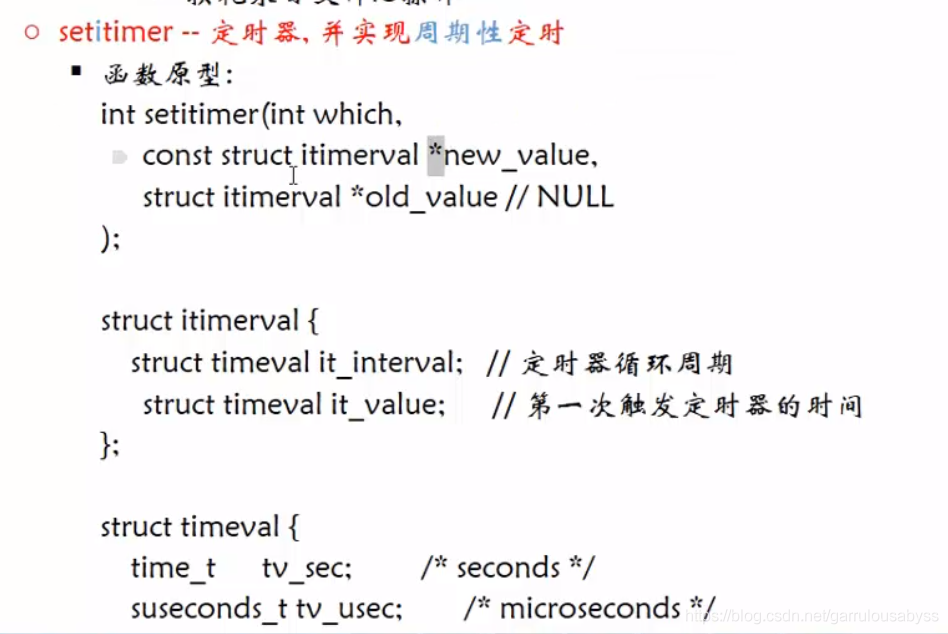五十六. setitimer定时器函数的使用


五十七. 阻塞信号集和未决信号集的关系


比如说我们要阻塞某些进程,先在自定义信号集中指定0或者1,再把自定义信号集,写进阻塞信号集。
五十八. 读当前进程的未决信号集


这里首先是signal_set.c
#include <stdio.h>
#include <unistd.h>
#include <stdlib.h>
#include <sys/types.h>
#include <sys/stat.h>
#include <string.h>
#include <signal.h>
int main(int argc, const char* argv[])
{
//每隔1s赌一次内存的未决信号集
while(1)
{
sigset_t pendset;
sigpending(&pendset);
//1~31
for(int i=1;i<32;i++)
{
//对每一个信号一次判断
if(sigismember(&pendset,i))
{
printf("1");
}
else
{
printf("0");
}
}
printf("\n");
sleep(1);
}
return 0;
}
运行一下这个程序
[root@VM_0_15_centos 7Day]# vim signal_set.c
[root@VM_0_15_centos 7Day]# ls
abort.c alarm_uncle.c kill.c setitimer.c sigmaks.c signal_set.c
alarm.c homework raise.c sigaction.c signal.c thread_attr.c
[root@VM_0_15_centos 7Day]# gcc signal_set.c -std=gnu99
[root@VM_0_15_centos 7Day]# ./a.out
0000000000000000000000000000000
0000000000000000000000000000000
0000000000000000000000000000000
0000000000000000000000000000000
0000000000000000000000000000000
0000000000000000000000000000000
0000000000000000000000000000000
0000000000000000000000000000000
0000000000000000000000000000000
0000000000000000000000000000000
0000000000000000000000000000000
0000000000000000000000000000000
显然这里由于没有信号阻塞,所以未决信号集里,全部是0
五十九. 设置信号阻塞
#include <stdio.h>
#include <unistd.h>
#include <stdlib.h>
#include <sys/types.h>
#include <sys/stat.h>
#include <string.h>
#include <signal.h>
int main(int argc, const char* argv[])
{
//手动屏蔽信号
//自定义信号集集合
sigset_t myset;
//清空集合
sigemptyset(&myset);
//添加要阻塞的信号
sigaddset(&myset,SIGINT);
sigaddset(&myset,SIGQUIT);
sigaddset(&myset,SIGKILL);
//自定义集合数据设置给内核的阻塞信号集
sigprocmask(SIG_BLOCK, &myset, NULL);
//每隔1s赌一次内存的未决信号集
while(1)
{
sigset_t pendset;
sigpending(&pendset);
//1~31
for(int i=1;i<32;i++)
{
//对每一个信号一次判断
if(sigismember(&pendset,i))
{
printf("1");
}
else
{
printf("0");
}
}
printf("\n");
sleep(1);
}
return 0;
}



六十. signal信号捕捉函数

signal.c
#include <stdio.h>
#include <unistd.h>
#include <stdlib.h>
#include <sys/types.h>
#include <sys/stat.h>
#include <string.h>
#include <signal.h>
void myfunc(int sig)
{
printf("cathc you signal: %d\n", sig);
}
int main(int argc, const char* argv[])
{
// 注册信号捕捉函数
signal(SIGINT, myfunc);
while(1)
{
sleep(3);
printf("hello!\n");
}
return 0;
}
运行结果:
[root@VM_0_15_centos 7Day]# vim signal.c
[root@VM_0_15_centos 7Day]# gcc signal.c
[root@VM_0_15_centos 7Day]# ./a.out
hello!
hello!
^Ccathc you signal: 2
hello!
^Ccathc you signal: 2
hello!
^Ccathc you signal: 2
hello!
hello!
^Ccathc you signal: 2
hello!
^Ccathc you signal: 2
hello!
^Ccathc you signal: 2
hello!
^Ccathc you signal: 2
hello!
hello!
hello!